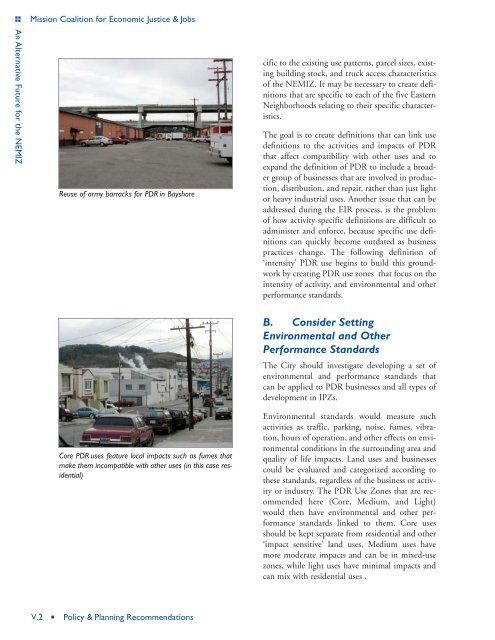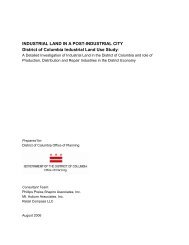An Alternative Future for the North East Mission Industrial Zone
An Alternative Future for the North East Mission Industrial Zone
An Alternative Future for the North East Mission Industrial Zone
You also want an ePaper? Increase the reach of your titles
YUMPU automatically turns print PDFs into web optimized ePapers that Google loves.
<strong>An</strong> <strong>Alternative</strong> <strong>Future</strong> <strong>for</strong> <strong>the</strong> NEMIZ<br />
<strong>Mission</strong> Coalition <strong>for</strong> Economic Justice & Jobs<br />
Reuse of army barracks <strong>for</strong> PDR in Bayshore<br />
Core PDR uses feature local impacts such as fumes that<br />
make <strong>the</strong>m incompatible with o<strong>the</strong>r uses (in this case residential)<br />
V.2 Policy & Planning Recommendations<br />
cific to <strong>the</strong> existing use patterns, parcel sizes, existing<br />
building stock, and truck access characteristics<br />
of <strong>the</strong> NEMIZ. It may be necessary to create definitions<br />
that are specific to each of <strong>the</strong> five <strong>East</strong>ern<br />
Neighborhoods relating to <strong>the</strong>ir specific characteristics.<br />
The goal is to create definitions that can link use<br />
definitions to <strong>the</strong> activities and impacts of PDR<br />
that affect compatibility with o<strong>the</strong>r uses and to<br />
expand <strong>the</strong> definition of PDR to include a broader<br />
group of businesses that are involved in production,<br />
distribution, and repair, ra<strong>the</strong>r than just light<br />
or heavy industrial uses. <strong>An</strong>o<strong>the</strong>r issue that can be<br />
addressed during <strong>the</strong> EIR process, is <strong>the</strong> problem<br />
of how activity-specific definitions are difficult to<br />
administer and en<strong>for</strong>ce, because specific use definitions<br />
can quickly become outdated as business<br />
practices change. The following definition of<br />
‘intensity’ PDR use begins to build this groundwork<br />
by creating PDR use zones that focus on <strong>the</strong><br />
intensity of activity, and environmental and o<strong>the</strong>r<br />
per<strong>for</strong>mance standards.<br />
B. Consider Setting<br />
Environmental and O<strong>the</strong>r<br />
Per<strong>for</strong>mance Standards<br />
The City should investigate developing a set of<br />
environmental and per<strong>for</strong>mance standards that<br />
can be applied to PDR businesses and all types of<br />
development in IPZs.<br />
Environmental standards would measure such<br />
activities as traffic, parking, noise, fumes, vibration,<br />
hours of operation, and o<strong>the</strong>r effects on environmental<br />
conditions in <strong>the</strong> surrounding area and<br />
quality of life impacts. Land uses and businesses<br />
could be evaluated and categorized according to<br />
<strong>the</strong>se standards, regardless of <strong>the</strong> business or activity<br />
or industry. The PDR Use <strong>Zone</strong>s that are recommended<br />
here (Core, Medium, and Light)<br />
would <strong>the</strong>n have environmental and o<strong>the</strong>r per<strong>for</strong>mance<br />
standards linked to <strong>the</strong>m. Core uses<br />
should be kept separate from residential and o<strong>the</strong>r<br />
‘impact sensitive’ land uses. Medium uses have<br />
more moderate impacts and can be in mixed-use<br />
zones, while light uses have minimal impacts and<br />
can mix with residential uses .












